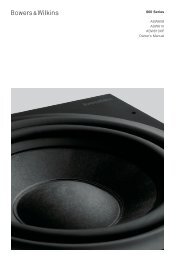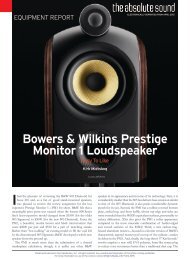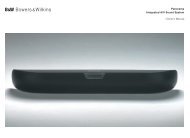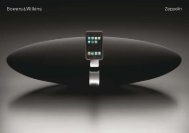CT8 XO Mk2 Manual - Bowers & Wilkins
CT8 XO Mk2 Manual - Bowers & Wilkins
CT8 XO Mk2 Manual - Bowers & Wilkins
Create successful ePaper yourself
Turn your PDF publications into a flip-book with our unique Google optimized e-Paper software.
Running In and Ancillary Equipment<br />
Ancillary Equipment<br />
Speakers of this ability deserve signals of the highest quality. Choose your<br />
electronic equipment and interconnecting cables with care. We can give<br />
guidance on what to look for when choosing ancillary equipment, but<br />
cannot recommend specific items. The standards of such products are<br />
improving all the time and your dealer will be able to demonstrate a variety<br />
of suitable up-to-date products.<br />
In the specification we recommend a range of amplifier powers. The<br />
higher figure is defined by the power handling capability of the speaker.<br />
When calculating the power handling, it is assumed that the amplifier is<br />
not run into clipping, which distorts the frequency power spectrum of the<br />
signal, and that the signal is normal programme material. Test tones from<br />
oscillators and the like are not applicable. The lower figure is the minimum<br />
we consider necessary to achieve reasonable listening levels without<br />
audible distortion in the smaller room (less than 60 m 3 or 2000 cu ft). The<br />
higher the power you use, the less likely you are to experience amplifier<br />
clipping.<br />
You can often tell how good an amplifier is at driving complex speaker<br />
loads by looking at its power rating into both 4Ω and 8Ω loads. The nearer<br />
the ratio is to 2:1 the better, as it indicates a good current capability.<br />
In order to reduce the effect the cable has on the frequency response of<br />
the speaker to inaudible levels, the impedance of the cable at all<br />
frequencies (measuring both positive and negative conductors in series)<br />
should be kept as low as possible and certainly below 0.1Ω. At low<br />
frequencies, the DC resistance of the cable is the dominant factor and you<br />
should choose a gauge of wire sufficient to achieve the impedance<br />
requirements over the length of cable you need to use. At mid and high<br />
frequencies the inductive component of the impedance can dominate the<br />
DC resistance. This and other properties influenced by the detailed<br />
construction of the cable become important.<br />
Running In<br />
The performance of the speakers will change subtly during the initial<br />
listening period. If they have been stored in a cold environment, the<br />
damping compounds and suspension materials will take some time to<br />
recover their correct mechanical properties. The drive unit suspensions<br />
will also loosen up during the first hours of use. The time taken for the<br />
speakers to achieve their intended performance will vary depending on<br />
previous storage conditions and how they are used. As a guide, allow up<br />
to a week for the temperature effects to stabilise and 15 hours of average<br />
use for the mechanical parts to attain their intended design<br />
characteristics.<br />
However, longer run-in periods (as long as a month) have been reported<br />
and there is evidence to suggest that this has little to do with the speaker<br />
changing and more to do with the listener getting used to a new sound. It<br />
is especially so with highly revealing speakers such as these, where there<br />
may be a significant increase in the amount of detail portrayed compared<br />
to what the listener has previously been used to; the sound may at first<br />
appear too “up front” and perhaps a little hard. After an extended period<br />
of time, the sound will seem to mellow, but without losing clarity and<br />
detail.<br />
22<br />
Aftercare<br />
Aftercare<br />
The speaker cabinet surfaces and the casing of the <strong>CT8</strong> <strong>XO</strong> usually only<br />
require dusting. If you wish to use an aerosol cleaner, remove any speaker<br />
grilles first by gripping round the edges and gently pulling them away from<br />
the cabinet. Spray onto the cleaning cloth, not directly onto the cabinet.<br />
The grille fabric may be cleaned with a normal clothes brush whilst the<br />
grille is detached from the cabinet.<br />
When replacing grilles, ensure that the pegs are correctly aligned with the<br />
receptacles in the cabinet before pushing into place.<br />
Avoid touching the drive unit diaphragms, especially the tweeter,<br />
as damage may result.











